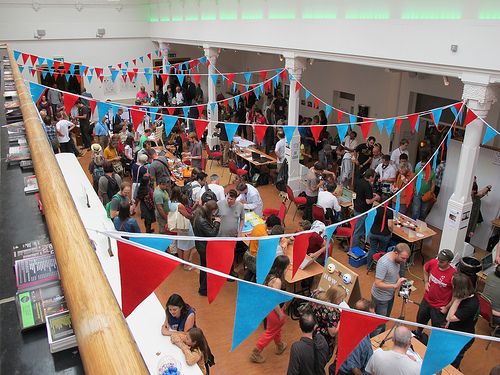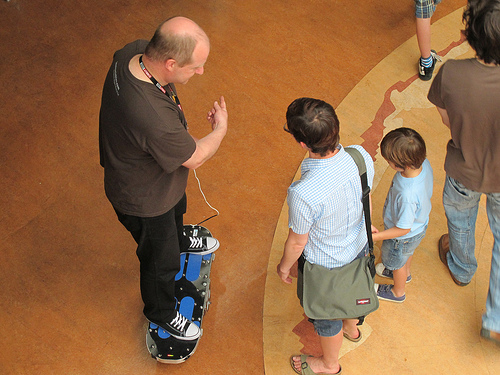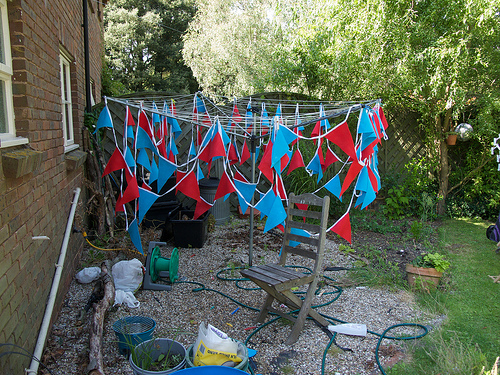Looking back on Brighton Mini Maker Faire
A week ago today, over 5000 people gathered in the foyer of the Brighton Dome for a day of hacking, crafting, tinkering, DIY, learning, creativity and inspiration. After 6 months of work, the first ever Brighton Mini Maker Faire arrived, and it was a great success, beyond anything we had dared to hope for.
We had crammed about 100 makers (at 50 stalls) into the venue, plus a few rogue Daleks who managed to sneak outside and terrify the people of Brighton. We had everything from giant felt portraits to microscopic sea creatures. Live electronics hacking and soldering workshops to gingerbread construction and crochet. Musical instruments of every variety, comic book guns and armour, retro computing, helicopters, self-balancing skateboards, smart fabrics and 3D printers.
I was on a continual high the whole day; seeing kids and adults alike leaning over tables to talk to makers, gasp in surprise at their work, smiling and chatting, and scribbling down notes about projects to look up and try themselves when they got home. And while it was undoubtedly a hot and crowded event, there were pools of calm, where people were absorbed in workshops, learning to solder Drawduinos or make Kanzashi.
<img class=”border”src=”/assets/flickr/6111673239_20719243bb.jpg” alt=”IMG_3393” />
I have mentioned some of my collaborators and our supporters already, but again, I offer sincere thanks to all our sponsors, volunteers and makers.
You can see write-ups on the website, Tumblr and Lanyrd page for the event. And there are hundreds of great photos and videos that give a flavor of the day on Flickr, as well as our lively Facebook page.
Here, I want to talk about some aspects of the event that make it interesting as a project to work on.
I’ve been working on digital projects for over 10 years, so it was a striking change to help put together a live event. A project where the deadline looms large over everything, and you bet the farm on one golden payoff on a single day.
It was fun to be working in a different milieu, collaborating with people from arts and culture institutions, hackers and makers who often work with digital tools, but usually as a means to a physical end.
The challenges are very different. Digital technology is young and fragile, and I’ve spent many evenings working with a team to route around problems in browsers, server software, code or content. With events, you’re working with much older technology: buildings, light, electricity, tables and chairs, food and drink — and of course, people. Hazards tend to be of the physical variety: fire, injury, space (or lack of it).
Engagement and scale
Of all the elements, people — and the way you engage with them — are the single biggest difference. The six months leading up to the event are a classic cat-herding process, with very little to show in the way of product until the night before the event, when we started to gather in one place, assemble stalls, hang bunting and hand out lanyards. With digital projects, content and code is often created from day one, while the launch can be something of an anti-climax, watching as a DNS change propagates, an app is deployed or some media inventory goes live.
A digital audience is heavily mediated; sitting in a distant room, connected to you only through a browser, computers, the pipes of the internet and a server sitting in a cooled facility somewhere you’ve never even been to. People are just users, unique visitors, cookies; and we’re interested in them often only in aggregate. I’ve rarely felt like I touched someone’s life through a digital project, no matter how useful.
By contrast, when someone is telling you how they’ve been inspired to make something, or how they wish their kids were being taught this stuff in schools, you can see their wide eyes and smiling face a couple of feet away. You can feel the energy in the room. You can hear the hoarseness in the voices of makers towards the end of the day, as they share their work with an unrelenting stream of curious visitors.
Events, in short, are massively engaging, in a way that digital products can never be, even social experiences like Facebook or rich, beautiful content like a National Geographic iPad app.
The flipside of this is scalability. Our ‘Mini’ Maker Faire was a grassroots-organised event. Everyone worked for free. Many of the high cost elements in the process or the final event were donated or supplied at a heavily discounted rate. The makers and their projects, who were, in effect, the ‘content’ of the event, came down for free, and mostly made their projects in their spare time. Even the big, official Maker Faires in the US, that charge $25 to get in, and draw 60-100,000 visitors, run at break-even. This is not a profit-making exercise. Which raises questions about how sustainable it is.
Grassroots projects
One of the reasons I got involved in digital tech 15-odd years ago, was that I could see it was a way of bringing grassroots communities together; to redistribute power in creative and disruptive ways. And that has been born out time and time again, usually with net positive results.
But for the past 10 years I’ve been working in client-agency relationships, where we’ve been using that technology to further a client’s aims. Anyone who’s worked in an agency wonders what it would be like to be creating their own projects, and a lucky few get to do both. This was my chance to go ‘client-side’; to work with a team of like-minded people to bring our collective project to fruition. I’m pleased to report that it is hugely satisfying!
Being a non-profit-making venture also gave us some freedom to make mistakes. We were risking time, reputation, goodwill and some resources, but not a huge amount of cash. We didn’t charge anyone to get in, so we didn’t feel pressured to make it ‘worth £5’. Everyone who contributed volunteered their energy, and if they weren’t happy about it, they were free to walk away. That freedom has very real value, and is too easily trampled over in commercial projects.
Looking forward
We were laying foundations for 2012 right from the start, considering what we could do this year, to give us leverage and options next. While we’re all looking forward to having some time off, to think about something else, we’re already exploring some of our options.
There are some interesting puzzles to consider, the biggest of which is sustainability (of the financial — rather than the environmental — kind). I believe the best model for supporting grassroots projects beyond a one-off sprint is social enterprise. We should look to be self-sustaining; while we shouldn’t be driven by commercial imperatives, I don’t want to be a charity either.
We need to find a balance that respects the amateur ethos of making, but can also operate in a world where people need to pay the rent; where we’re not dependent on an endless supply of donated time, resources, services and energy.
I’m optimistic that we can forge a path that respects this balance. There are interesting models of social enterprise springing up all the time, especially in the Maker world, from hackspaces, to craft workshops and fablabs.
Ironically, Mini Maker Faires are themselves an answer to a larger problem of scalability and sustainability for O’Reilly, who put on the official Maker Faires. The ‘Mini’ denotes an officially licensed, but independent, grassroots Faire. Sanctioned and supported by O’Reilly, but not funded by them. Rather like the difference between TEDx and TED.
We gathered and generated energy last weekend, much of which was left under-exploited. While many people left inspired to make themselves, many could have been given more information, support or resources to help them take it further. All of which suggests to me that there are opportunities to make this sustainable.
It also suggests there might be room for more than one annual event in Brighton. Could we run smaller workshops under the Mini Maker Faire banner? Or put on more parties like the one we had in the evening? They could be fund-raisers, or just events to help support a more sustained engagement. And if we were to run more regular learning-style events, where we equipped people with the skills to make, what should be the relationship between Build Brighton (which already runs workshops) and Mini Maker Faire (which was a Build Brighton event)? Would they generate revenue, or would they just be more work made possible by volunteers?
I don’t know, but I’m looking forward to figuring all this stuff out.
Update, 19 September: I just came across this interesting approach to the sustainability puzzle. Rhode Island Mini Maker Faire have part-funded their event with a Kickstarter project. With about 50 backers, and a modest goal of $2,500, it’s too early to say whether this kind of micro-patronage/crowd-funding approach could work on a big scale. None-the-less, a great idea, and well-worth trying out.
(An interesting detail, whether by design or not, they left the deadline for the funding project open til after the Faire itself. I imagine that way, people who had come along and been inspired might contribute after the event.)




